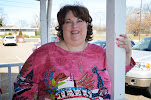The orange color ribbon is for leukemia awareness. Here is the ornament I have stitched for two leukemia patients that have touched my heart.


In the center of the ornament is a charm. One side says "Love Much" and the other side says "Laugh Often"
Kim was a leukemia patient I never met, but had the joy of trying to find her a bone marrow match. I spent a lot of time with her mom and dad and with her kids. Kim had 3 boys and a husband who loved her along with her parents and aunts and uncles and friends. She is the "Love Much" side of the ornament for she was loved much. Kim fought the good fight. But in the end, this horrible disease took her from us much, much too soon.
Justin was also a leukemia patient. He developed leukemia when he was a child, went into remission and lived several years cancer free. But it raised it's ugly head when he was about 15. Justin is the "Laugh Often" side of my ornament. He was one of our spokespersons for the need for blood and bone marrow donors. Justin saved literally hundreds of lives through people who just wanted to help, but weren't a match for Justin. In the end, Justin just wanted to be a normal teenager, not a spokesperson.
His senior year of high school, Justin was so sick, but still had to try to keep up his muscle strength. But he didn't have much inspiration for working out. That is until some young, beautiful girl said YES to his invitation to prom or maybe he said yes to her invitation, I don't remember. But whatever, his mom said that day he went to lifting weights and working out again. He wanted to "laugh much".
Justin is now resting at peace, his body no longer in pain. I miss him much.
Now here is the scoop on leukemia:
Acute lymphocytic leukemia (ALL), also called acute lymphoblastic leukemia, is a cancer that starts from white blood cells called lymphocytes in the bone marrow (the soft inner part of the bones, where new blood cells are made). In most cases, the leukemia invades the blood fairly quickly. It can then spread to other parts of the body including the lymph nodes, liver, spleen, central nervous system (brain and spinal cord), and testes. Other types of cancer that start in these organs and then spread to the bone marrow are not leukemia.
The other types of cancer that start in lymphocytes are known as lymphomas (non-Hodgkin lymphoma or Hodgkin disease). The main difference between these types of cancers is that ALL starts in the bone marrow and may spread to other places, while lymphomas start in lymph nodes or other organs and then may spread to the bone marrow. Sometimes cancerous lymphocytes are found in both the bone marrow and lymph nodes when the cancer is first diagnosed , which can make it hard to tell if the cancer is a leukemia or a lymphoma.. If more than 25% of the bone marrow is replaced by cancerous lymphocytes, the disease is usually considered to be a leukemia. The size of lymph nodes is also important. The bigger they are, the more likely the disease is a lymphoma. For more information on lymphoma, see our document, Non-Hodgkin Lymphoma.
The term "acute" means that the leukemia can progress quickly, and if not treated, would probably be fatal in a few months. "Lymphocytic" or "lymphoblastic" means it develops from cells called lymphocytes or lymphoblasts. This is different from acute myeloid leukemia (AML), which develops in another white blood cell type found in the bone marrow.Types of Leukemia
Not all leukemias are the same. Leukemias are divided into 4 main types. Knowing the specific type of leukemia can help doctors better predict each patient's prognosis (outlook) and select the best treatment.
Acute Leukemia Versus Chronic Leukemia
The first factor to consider in classifying a patient's leukemia is if most of the abnormal cells are mature (look like normal white blood cells) or immature (look more like stem cells).
Acute leukemia: In acute leukemia, the bone marrow cells cannot mature properly. Immature leukemia cells continue to reproduce and build up. Without treatment, most patients with acute leukemia would live only a few months. Some types of acute leukemia respond well to treatment, and many patients can be cured. Other types of acute leukemia have a less favorable outlook.
Chronic leukemia: In chronic leukemia, the cells can mature partly but not completely. These cells are not really normal. They generally do not fight infection as well as do normal white blood cells. And, of course, they survive longer, build up, and crowd out normal cells. Chronic leukemias tend to progress over a longer period of time, and most patients can live for many years. However, chronic leukemias are generally harder to cure than acute leukemias.
Myeloid Leukemia Versus Lymphocytic Leukemia
The second factor to consider in classifying leukemia is the type of bone marrow cells that are affected.
Myeloid leukemia: Leukemias that start in early forms of myeloid cells - white blood cells other than lymphocytes, red blood cells, or platelet-making cells (megakaryocytes) - are myeloid leukemias (also known as myelocytic, myelogenous, or non-lymphocytic leukemias).
Lymphocytic leukemia: If the cancer starts in early forms of lymphocytes, it is called lymphocytic leukemia (also known as lymphoid leukemia). Lymphomas are also cancers of lymphocytes. But, unlike lymphocytic leukemias, which develop in the bone marrow, lymphomas develop from lymphocytes in lymph nodes or other organs.
By considering whether they are acute or chronic, and whether they are myeloid or lymphocytic, leukemias can be divided into 4 main types:
acute myeloid (or myelogenous) leukemia (AML)
chronic myeloid (or myelogenous) leukemia (CML)
acute lymphocytic (or lymphoblastic) leukemia (ALL)
chronic lymphocytic leukemia (CLL)
Although ALL is the most common of the 4 major types of leukemia among children, it is actually the least common type among adults.






















